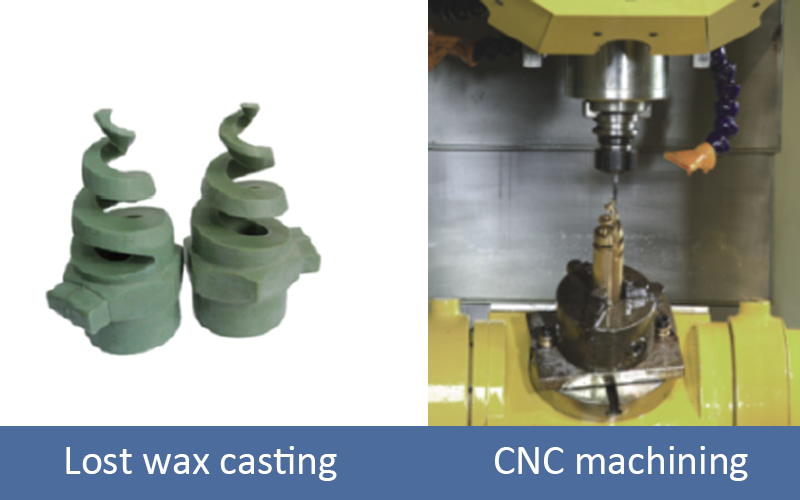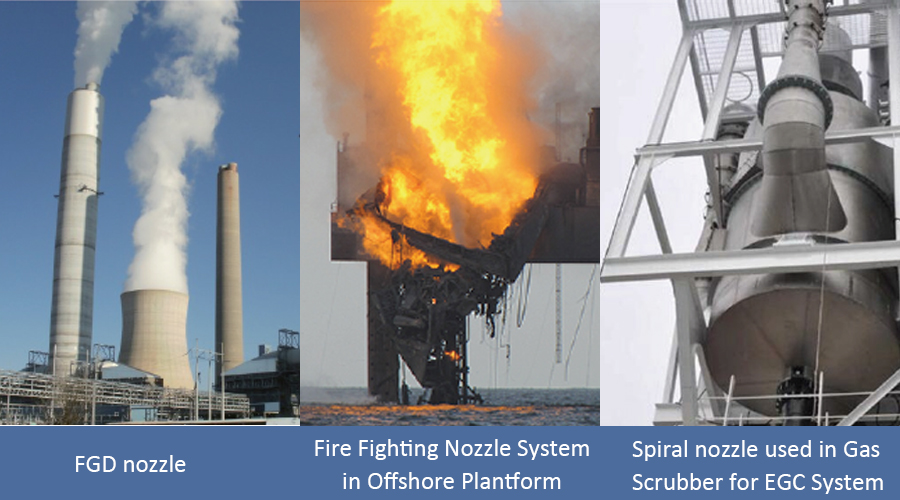spiral nozzle, also called “Pigtail nozzle”, is a kind of spray nozzle utilising specially designed flow deflector surface to shearand break the liquid and then shape the expected spray pattern.
spiral nozzles have the simplest structures and maximum flow passages. They are widely used in industrial applications, such as flue gas cooling, washing and rinsing, fire fighting, etc.
Design Features
- Compact one-piece structure permit maximum liquid through for a given pipe size- Free passage design minimizes clogging and provide high discharge velocity
- Large coverage of spray angles and capacity
- Full cone and hollow cone spray pattern available
- Spray angles :60°, 90°, 120°, 150°, 170°
-
Flow rates :2.6 L/min - 2000L/min at 0.7 bar
Full cone VS. Hollow cone
Water flow goes through the inlet and impact the spiral deflect surface. Then then water is sheared and broken into medium to large droplets to form a cone shape spray. According to different deflect surface design, the droplets can be shaped into single layer or multiple layer, which the former is the so-called hollow cone spray pattern and the later is full cone spray pattern.Is it strictly full cone ?
The full cone here is not a strictly full cone pattern since there are gaps between the layers. See the comparison below of flow distribution of full cone spiral nozzle and standard full cone nozzle.
Different material, different technique
- Lost wax castingApplicable material: 304SS, 316SS, 316L, 310SS, Hastelloy, etc.
Wax embryos are first machined by CNC, then are sent to casting mill to form the mental cast blanks. After solution treatment, surface treatment and thread maching, the sprial nozzles then are finished.
-Die Casting
Applicable material: 304SS, 316SS, 316L, 310SS, Hastolloy, etc.Die casting is a metal casting process that is characterized by forcing molten metal under high pressure into a mold cavity.
- CNC machining
Applicable material: Brass, PVC, PP, POM, Teflon, PVDF, etc.The softer material can be machined by CNC directly.- Injection moulding
Applicable material: PVC, PP, POM, Teflon, PVDF, etc.Plastic material are suitable for this method.- Sintering
Applicable material: Silicon carbide, Ceramic and etc.Sintering is the process of compacting and forming a solid mass of material by heat and/or pressure without melting it to the point of liquefaction.This method is suitable for inorganic material.
Applications
EGC System
One of customers are designing their Exhaust Gas Cleaning Systems(EGC) for marines.
The scrubber system in this EGC system is designed to remove SOxm from the exhaust and operates utilising seawater. Spiral nozzles are designed in the scrubber system for seawater spray, and during this process, the natural alkalinity in seawater is utilized for scrubbing, and does not need caustic soda.
FGD
Many coal fired electric utilities have utilized wet scrubbers to remove SO2 (acid rain) from the gases being discharged into the atmosphere. The process is called Flue Gas Desulfurization or FGD.Wet FGD (WFGD) Scrubbers utilize a lime slurry that is sprayed in an open tower to neutralize the gas stream.
The function of a spray nozzle in an open tower wet scrubber is to convert bulk liquid into drops maximizing the surface area of the liquid and the chemical reaction between the lime slurry and the SO2 in the gas stream.
Fire Fighting System in Offshore Plantform
Since the spiral nozzles have relatively high velocity of spray, larger coverage and high efficiency of atomization, they have good perform in applications of fire fighting.There are two types of our spiral nozzle, k=24.6 and k=36.7, once usedin offshore drilling platform. They are designed to protect the expensive devices on the offshore platform.


